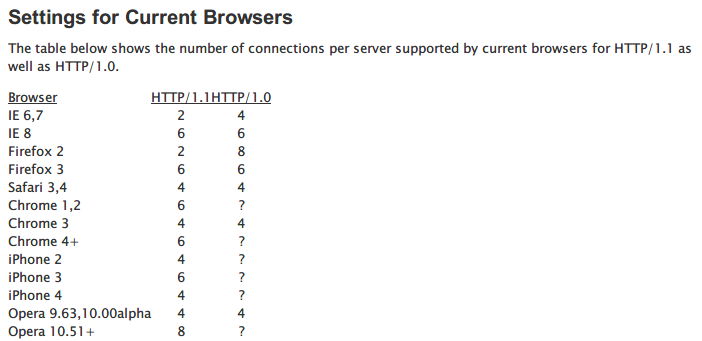开始的流程:
1、先发请求给DNS进行域名解析获取服务器IP
2、向步骤1获取的服务器IP发送HTTP请求
//服务器的内部处理
3、服务器接收请求后,解析主机头对应的站点,把请求传送给站点
//返回http
4、站点接受转发的请求作出回应并返回HTTP回应
//解析头部
5、浏览器接到返回的HTTP回应,解析头信息和HTML主体
6、根据解析的头信息设置必要的数据,如cookie,编码,语言等声明的处理
7、在6的基础上对HTML主体进行渲染展现;
这个是别人的并发测试;

nodeJS的代码:

var express = require('express'); var path = require('path'); var favicon = require('serve-favicon'); var logger = require('morgan'); var cookieParser = require('cookie-parser'); var bodyParser = require('body-parser'); var routes = require('./routes/index'); var users = require('./routes/users'); var app = express(); // view engine setup app.set('views', path.join(__dirname, 'views')); app.set('view engine', 'jade'); // uncomment after placing your favicon in /public //app.use(favicon(__dirname + '/public/favicon.ico')); app.use(logger('dev')); app.use(bodyParser.json()); app.use(bodyParser.urlencoded({ extended: false })); app.use(cookieParser()); app.use('/', function(req, res, next) { setTimeout(function(){ next(); },10000); }); app.use(express.static(path.join(__dirname, 'public'))); app.use('/', routes); app.use('/users', users); // catch 404 and forward to error handler app.use(function(req, res, next) { var err = new Error('Not Found'); err.status = 404; next(err); }); // error handlers // development error handler // will print stacktrace if (app.get('env') === 'development') { app.use(function(err, req, res, next) { res.status(err.status || 500); res.render('error', { message: err.message, error: err }); }); } // production error handler // no stacktraces leaked to user app.use(function(err, req, res, next) { res.status(err.status || 500); res.render('error', { message: err.message, error: {} }); }); require("http").createServer(app).listen(3000); module.exports = app;
我自己测试了下,chrome的结果是6个,对于图片chrome会先请求加载一个, 后面再一个个加载, 目测一个域名下最多有6个是对的:
FF下的结果也一样,不过对于图片请求处理和chrome有点区别:

因为浏览器的并发也是有最大值的, 所以把服务器的图片放到同服务器的的二级域名下,那么就可以突破浏览器6个的并发限制, 请求会变成N倍,是hack ,已亲测;
首先,浏览器要把当前界面进行unload, unload的时间要看当前界面的HTML;
然后,浏览器从DOM开头由上到下步步渲染,link以及script依次加载和执行绘制, 此时的document.readyState为loading或者是interactive, 在线测试地址;
<!DOCTYPE html> <html> <head> <title></title> <meta charset="utf-8"> </head> <body> <script src="js.js"></script> <script> document.write("<br>"+"执行内部js"+ window.performance.now()); </script> </body>

img,link或者是script标签都是并行下载,但是link和script一开始执行就会阻塞浏览器的渲染;(而且此时的script标签中可以使用document.write往dom中写入数据;)
如果link或者script都是动态生成的话,他们都是异步加载,异步执行, js可能在link之前或者之后执行,在线测试地址:
<!DOCTYPE html> <html> <head> <meta charset="utf-8"> <title>JS Bin</title> </head> <body> <p style="color:#f00"> 红色的P标签: </p> <script> var p = document.getElementsByTagName("p")[0]; document.writeln( window.getComputedStyle(p,false)["color"] ); </script> <script> var link = document.createElement('link'); link.href = "p-green.css"; link.rel = "stylesheet"; document.head.appendChild(link); var script = document.createElement('script'); script.src = "p-green.js"; document.head.appendChild(script); </script> </body> </html>
上图的代码执行后的有两种情况:


动态生成的script标签也是异步的(并行下载,并行执行),点击查看demo;
<!DOCTYPE html> <html> <head> <meta charset="utf-8"> <title>JS Bin</title> </head> <body> <script> window.onload = function() { alert("加载好了;") }; for(var i=0;i<5;i++) { var sc = document.createElement("script"); sc.src="js"+i+".js"; document.head.appendChild(sc); }; </script> </body> </html
script是顺序添加到DOM中,但是没有按照先后顺序;

如果script是异步的也就是有一个async属性(IE中为defer)属性或者是动态生成的, 那么这些js会在DOMContentLoaded和onload之前执行;
当界面中的dom以及渲染成树形了,那么此时document.readyState 就会变成compelete, 触发DOMContentLoaded的事件(DOM3事件);
<!doctype html> <html> <head> <meta charset="utf-8"> <title>无标题文档</title> </head> <body> test <iframe src="iframe.html"></iframe> <img src="https://ss0.baidu.com/6ONWsjip0QIZ8tyhnq/it/u=2723971161,380468241&fm=58" /> <script> document.onreadystatechange = function() { console.log(document.readyState); if(document.readyState === "complete") { alert("complete"); }; }; window.onload = function() { alert("onload"); }; window.frames[0].onload = function() { alert("iframeLoad"); }; document.images[0].onload = function() { alert("imgLoad") }; document.addEventListener&&document.addEventListener("DOMContentLoaded",function() { alert("DOMContentLoaded") }) </script> </body> </html>
标准浏览器的执行顺序为 "DOMContentLoaded", "imgLoad", "iframeLoad", "complete", "load";
DOMContentLoaded以后会下载图片, iframe等等一些需要网络的节点, 最后会触发onload事件, 咕~~(╯﹏╰)b;
onload一旦执行,那么浏览器就从加载阶段进入了事件驱动阶段了,如果js有很多,那么在界面加载的时候会很慢很慢, 可能要很久,用户才能对看到界面或者进行操作, 优化加载速度可以参考这里;
额外也测试了几个网站的DOM加载完毕和onload的时间, 加载快的确体验好点;
www.qq.com 加载DOMContentLoaded用了1.5--2.0秒钟,onload触发用了6到10秒,
www.baidu.com 加载DOMContentLoaded用了1.5--2.0秒钟,onload触发用了2.5--3.0秒,
www.cnblogs.com 加载DOMContentLoaded用了0.4秒钟,onload触发用了1.5--2.0秒(中国销量遥遥领先),
www.sohu.com 加载DOMContentLoaded用了2.5--3.0秒钟,onload触发用了6-7秒,
参考了知乎的回答: openIT ;
在线获取浏览器最大连接数的测试地址: openIT (不好用);
两年前的资料:openIT;
HTTP1.0协议HTTP1.1协议的区别,openIT; (HTTP1.0只能玩短连接, HTTP1.1可以玩长连接)
参考地址:http://www.iefans.net/liulanqi-zuida-bingfa-lianjieshu/
老外的在线测试并发网站:http://stevesouders.com/hpws/parallel-downloads.php?t=1429612958 (╮(╯﹏╰)╭)
本屌神马都没有测试出来:http://www.iefans.net/liulanqi-zuida-bingfa-lianjieshu/
chrome的timeline是好东西: ![]() , 可以看到dom加载的时间线渲染js执行的时间重绘等, 然后做对应的优化, chrome使用方法,点击打开
, 可以看到dom加载的时间线渲染js执行的时间重绘等, 然后做对应的优化, chrome使用方法,点击打开
document.readyState的资料,打开带我飞;
UI线程的阻塞 ,又一个大神的 一篇好文;
面试题:

var ver = "global"; function test() { var ver = "1111"; var fun = new Function("arg","console.log(ver); console.log(arg); return arg;") ; fun("localVar"); }; test(); function test() { var x = 1; with ({x: 2}) { eval('function foo() { console.log(x); }'); eval('var bar = function() { console.log(x); }'); } foo(); bar(); } test();
作者: NONO
出处:http://www.cnblogs.com/diligenceday/
QQ:287101329
